The other day a neighbour knocked on my door and asked if I knew I had ragwort growing in my garden and what I was going to do about it. My replies were ‘yes’ and ‘nothing’ in that order, to which he responded in a slightly tongue-in-cheek tone that it was a ‘notifiable’ weed and that he would have to report me. I have a bit of grounding in the subject as this was not the first time I had faced the question so, as the clenched-teeth polite conversation continued, I told him there was no such thing in English law as a ‘notifiable’ weed and perhaps he meant one of the five plant species classed as ‘injurious’ in the Weeds Act of 1959. The named plants are Spear Thistle Cirsium vulgare, Creeping Thistle Cirsium arvense, Curled Dock Rumex crispus, Broad-leaved dock Rumex obtusifolius and Ragwort Senecio jacobaea. All are great for invertebrates and I am proud to say I have all five in my garden. Anyway, when I asked him to point out the offenders I was able to tell him (rather smugly I admit) that the plants in question were not in any case Common Ragwort Senecio jacobaea but Hoary Ragwort Senecio erucifolius (a forgivable mistake) and Smooth Hawk’s-beard Crepis capillaris (less so) neither of which has any whiff of illegality associated with them.
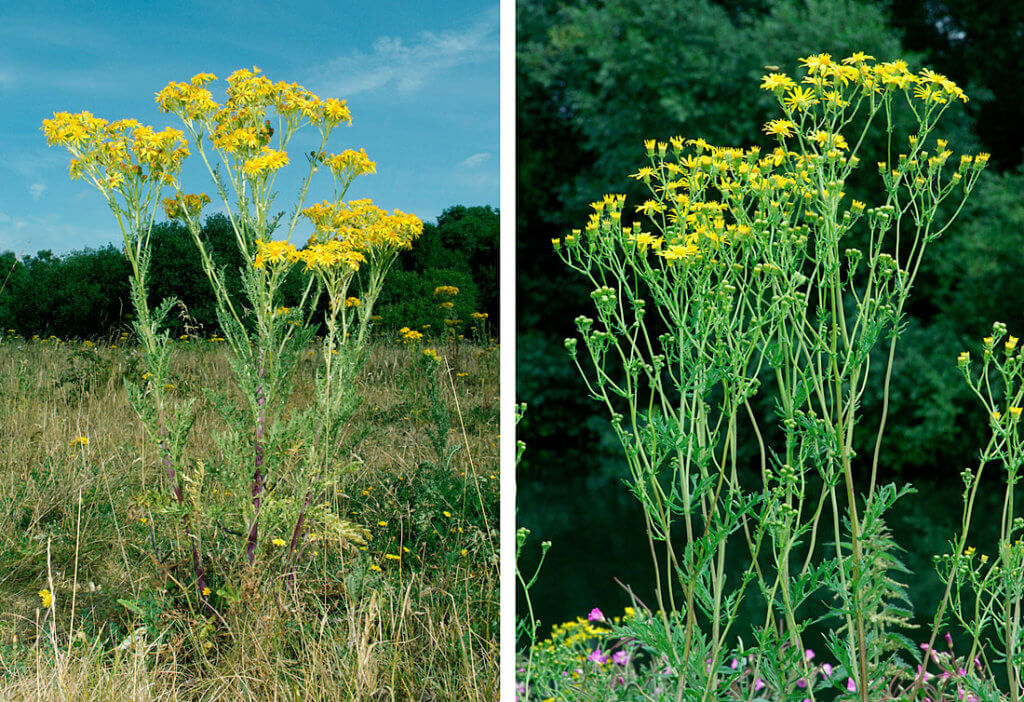
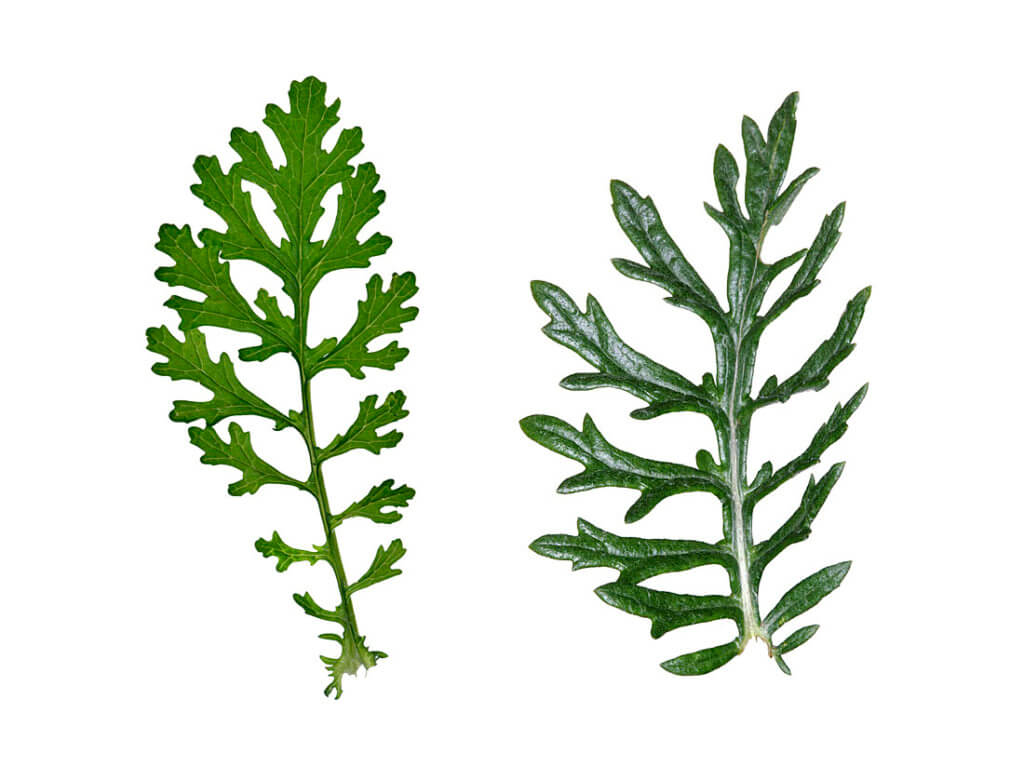
I have a botanical and natural history interest in Common Ragwort Senecio jacobaea but I can’t claim to be an expert when it comes to the law. So previously I had done my homework and gleaned a lot of authoritative information (and some dismaying evidence of wildly inaccurate scaremongering) from two excellent websites: ‘Ragwort Facts’ http://www.ragwortfacts.com/ and the Buglife pdf ‘Ragwort: Noxious weed or precious wildflower?’ https://www.buglife.org.uk/sites/default/files/Ragwort.pdf
If you like to check things for yourself I suggest you read The Weeds Act of 1959. It is easily accessible online and as legal documents go it is straightforward https://www.legislation.gov.uk/ukpga/Eliz2/7-8/54/contents It names five plants specifically and states that where the Minister (then MAFF) ‘is satisfied that where there are injurious weeds to which this Act applies growing upon any land he may serve upon the occupier of the land a notice in writing requiring him, within the time specified in the notice, to take such action as may be necessary to prevent the weeds from spreading.’ Bear in mind that ‘injurious’ does not mean poisonous and rather it relates to plants that might have an economic impact on farming. And it’s all about the potential for ‘spreading’ rather than merely having them on your land. As far as I can see you can grow as much of the five as you like and there’s no legal requirement to remove them unless the Secretary of State asks you to do so.
The other bit of legislation that relates to ragwort is The Control of Ragwort Act 2003 and it is also worth a read. It is brief and to the point and enables a Code of Practice to be laid down. Said code (dated 2004) can be viewed at http://www.defra.gov.uk/publications/files/pb9840-cop-ragwort.pdf and is introduced by Rt Hon Alun Michael MP who signs off by referring to himself as ‘Minister of State for Rural Affairs and Local Environment Quality and Minister for the Horse’. The latter reference strikes me as rather odd, and I can only suppose it is some form of whimsy. Make up your own mind but for me the document is oddly schizophrenic: at one turn it conjures up nightmare visions of dead and dying horses – hundreds of them – dropping like flies through ragwort poisoning; and at the other extreme it extols the virtues and value to wildlife of Senecio jacobaea. I may be wrong but it has all the hallmarks of a document written by committee, but a committee whose polarised members could not agree.
Despite the dystopian world, littered with dead horses, that the Code of Practice depicts it states: ‘The scale and extent of illness and death in animals through ragwort poisoning is difficult to determine, as an autopsy would be required in every case to confirm the exact cause of death. There is no current test available to diagnose accurately whether an animal is suffering from ragwort poisoning, and certainly no test to help determine whether any such poisoning relates to ingestion of conserved or live ragwort.’ So in other words the ‘evidence’ is unfounded.
I have nothing against horses but if you accept the above statement and choose to believe the facts as presented on the websites mentioned above then the risks to horse health are hugely exaggerated, as are the attributed number of deaths. That Common Ragwort contains toxins is not in dispute, but so do any number of other native wildflowers. And in the context of horses and other livestock perhaps living Ragwort is better described as distasteful rather than poisonous – the evidence of my own eyes tells me that horses avoid it and where I live an abundance of the plant is usually a clear indication of over-grazing. For those with concerns about the floral makeup of the English countryside maybe Common Ragwort should not be top of the list. A better contender might be Hemlock Water-dropwort Oenanthe crocata. I have heard this umbellifer described as the most poisonous plant in the UK (although how that was established I don’t know) but near me it thrives in eutrophic ditches (beside which horses trot) enriched by fertiliser run-off from intensively farmed fields. In the grand scheme of things I would suggest that intensive farming and eutrophication are subjects really worth worrying about.
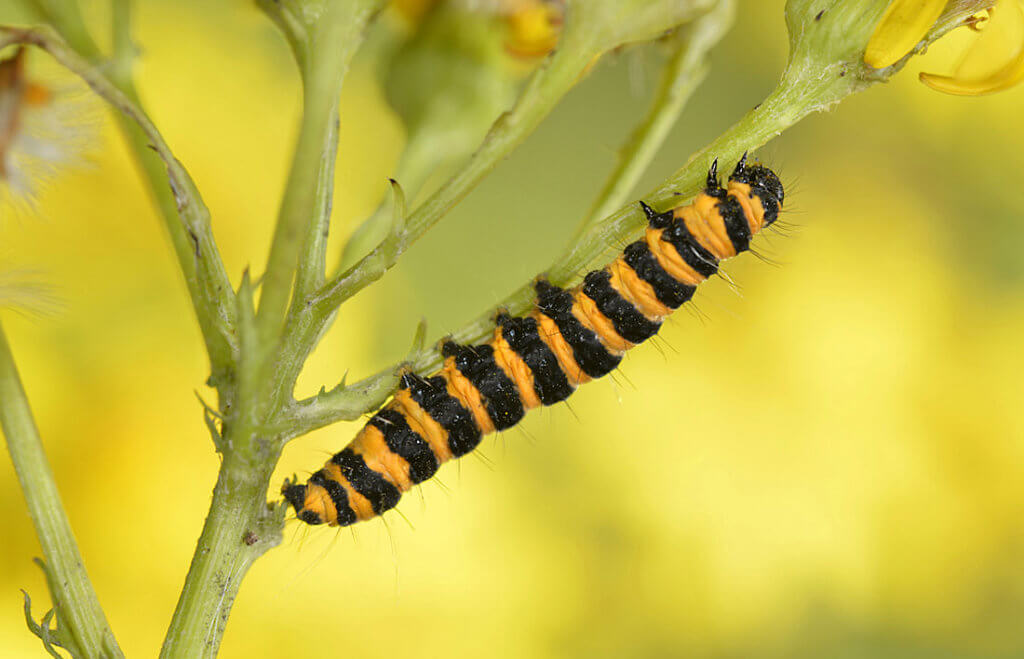
Stepping back from the issue of toxicity and livestock, Common Ragwort Senecio jacobaea is a hugely important native wildflower and an integral component in meadows. It is a wonderful source of nectar for insects, and according to Buglife there are 30 invetebrates that are confined to it; this number includes of course the Cinnabar Moth Tyria jacobaeae, caterpillars of which feed on nothing else.
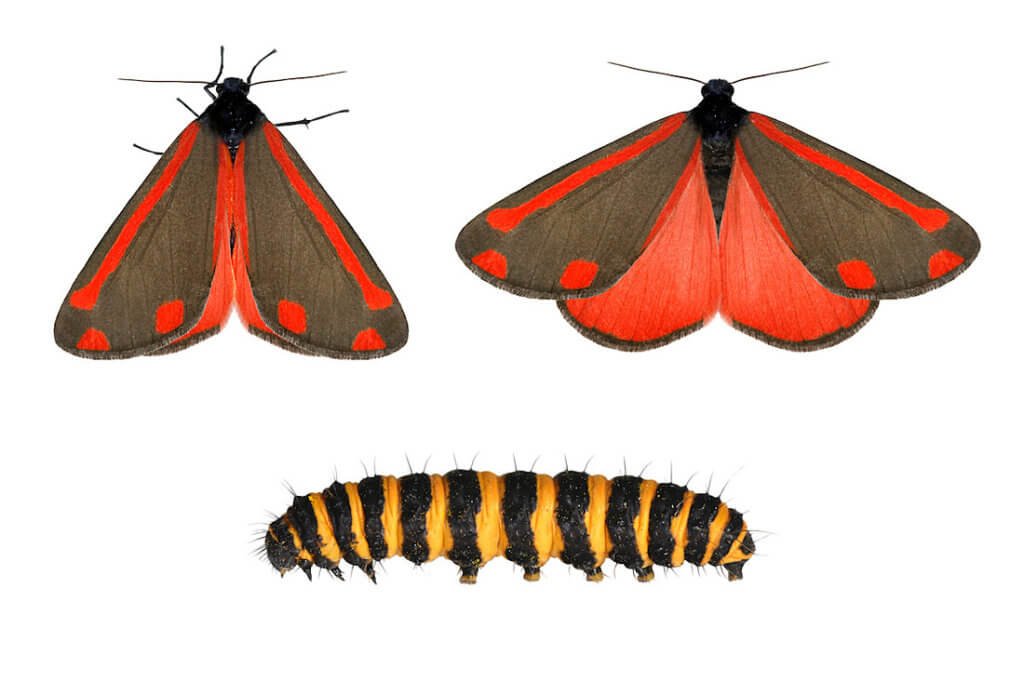
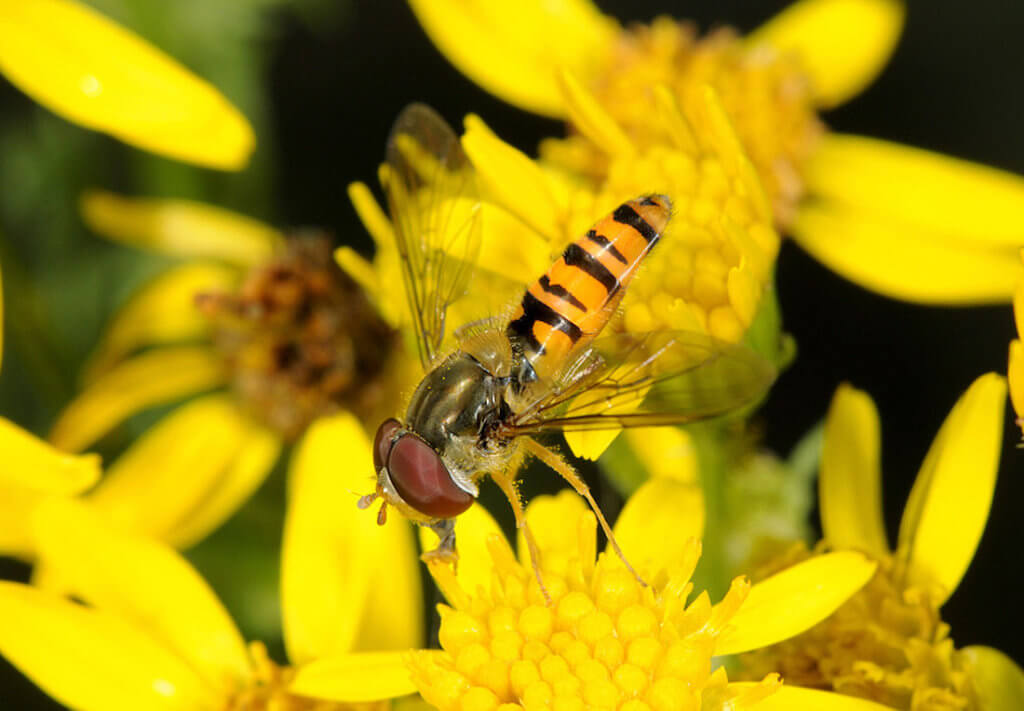
In some specific circumstances there may be a case for controlling ragwort in the context of its ‘injurious’ status – the potential for spreading leading to an economic impact on adjacent farmland – and perhaps even regarding livestock. Fine, so long as the perceived ‘need’ for control is based on real evidence and the Secretary of State has had his or her say on the matter. But whatever the rights and wrongs of Common Ragwort Senecio jacobaea, it is undeniably the only species of Senecio (or yellow composite come to that) that is specified in The Weeds Act of 1959. Nevertheless, I have a feeling that my neighbour may not be alone when it comes to mistaken identification. I have come across formal complaints about a perceived lack of ‘Ragwort control’ beside motorways and dual carriageways. For a start, unless the adverse consequences of ‘injurious’ spreading can be demonstrated I can’t see there is a legal requirement to ‘control’ it unless a minister deems it necessary. But more significantly the species in question is more likely to be Oxford Ragwort Senecio squalidus than Common Ragwort Senecio jacobaea. I can see no legal basis for the former species to be ‘controlled’ despite the strange claim in the Code of Practice that other species of ragwort ‘may need to be controlled’. Sadder still, many years ago I remember visiting Fair Isle and coming across a team of National Trust for Scotland volunteers ‘pulling ragwort’. Pointless though the exercise would have been even if they had been pulling Senecio jacobaea, their piles of vegetation comprised mainly Marsh Ragwort Senecio aquaticus.
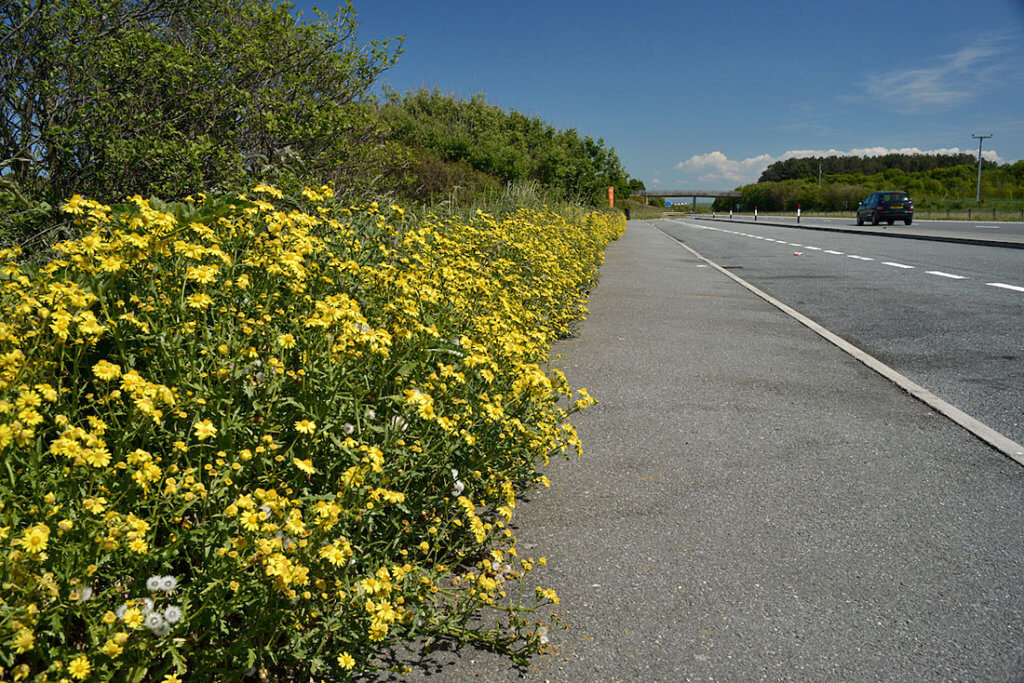
Yes, the usual ‘hate first, think later’ prejudice of the hard-of-thinking. Prepared to accept any damage to our world just to prevent the tiniest risk to their pet. Even if the risk isn’t real. Thank you for some real facts. Can’t believe the way some conservation organisations are prepared to pull ragwort out (even if they can really identify it, as you point out), in total opposition to their supposed aims.
I am the author of the ragwortfacts website mentioned so naturally I am delighted to see this excellent blog entry. There are a few extra things about this issue which may be of interest to readers.
First a piece of humour. As a Welsh-speaking Welsh man I always think that the name Defra is very appropriate here since the identically pronounced Welsh word “deffra” is a command and means “Wake up!”, which they should on this issue.
Essentially, there is a hysteria over the plant fueled by people just making things up and putting them in the press. I have taken things to the Advertising Standards Authority(ASA)and the press regulators both old and new on this. It is not always easy because of a general problem of people not being educated in critical thinking. You get harrassed and even stalked on the internet for standing up for good science and good thinking on this issue. Emotions run high about this issue because of the fake stories.A very prominent journalist called me crazy in public not long ago after I asked him for evidence to support his false assertions.
A few facts, a biopsy cannot actually confirm ragwort poisoning. Aside from the fact that the same overall type of toxins are present in 3% of the world’s plants, toxins present in mouldy feed such as hay have the same biochemical effect which shows up in the same way under a microscope.
The term injurious weed is a peculiar one that dates from the 1920s. The Weeds Act was just an undebated replacement for the original early 1920s legislation. This was a time when many more MPs were Rees Moggish toffs who were instilled with Latin at boarding school. Injurious, derived from the Latin for ” an injustice done to someone or something”, actually means harmful to the interests of 1920s pre-industrialised agriculture, but it leads to people like Natural England telling people to wear protective clothing when handling dock leaves. You know the plants you rub on nettle stings!
Defra use a bizarre invalid and indeed innumerate method to estimate risk in their Code of Practice. They claim it is based on a wrong number of impossibly confirmed cases, from an institution, which actually only had one possible case in 8 years and extrapolate that tiny figure from an anti-ragwort campaigner at that institution as if it fitted the whole country. It is morally unacceptable in my honest opinion to do that.
I have a blog on this issue as well as a website. On the blog I write about more current and immediate issues in more informal way. The latest blog entry covers a really bad article written by the academic from the institution which Defra uses as I mentioned above. http://ragwort-hysteria.blogspot.com/2019/04/ragwort-germination-and-spread-nonsense.html
Just to summarise. He claims that ragwort is poisoning the cinnabar moth and responsible for its decline, when it is actually the essential food of the moth.( Crazy or what?!”)
He uses figures that have been banned subsequently by the ASA from an advert. (He appears to be the original source of these.) He makes wildly wrong estimates about the level of poisoning,subsequently disproved by data from his own institution’s research and gets the law wrong just in the manner of the article above.
The bottom line here is that if an anti-ragwort article is published almost anywhere it will be inaccurate about something and often wildly so. It will be based on propaganda from a campaign and this is the core of the problem.
Neil – thank you.
Neil: Are saying that hoary ragwort is not toxic or has less toxicity than common ragwort or has the same toxicity? I am sure many horse owners would like to know. And yes, I do know the difference both above ground and below – the root structure is completely different.
Correct me if I’m wrong (I’m sure somebody will!) but I understood that the problem with Ragwort was that when cut and dried and made into hay it becomes “sweet” and horses will then eat it and that can be a problem. Probably more so if you are buying in hay rather than making it yourself. I agree with the overgrazing comment quite often it seems that horse paddocks are just bits of green carpet for horses to stand on rather than feed from as everything vaguely edible has been grazed to the floor and only the inedible plants thrive.
I remember working on a farm in Pembrokeshire 40 odd years ago where we lost cattle through water dropwort poisoning. The ditches had been cleaned out with a JCB and the spoil including dropwort plants left on the edge of the ditch . The cattle eating the plant when dried out that they wouldn’t touch when green.
Horses and especially ponies generally need pretty poor pasture. Otherwise they can get all sorts of problems.
Thanks Paul, that is all accurate.
In the British Horse Society survey (Summer 2014) 98% of respondents were confident that they would recognise Common ragwort if they saw it growing – BUT in fact 17% of responses to fairly simple photos were misidentifications. Species such as Fleabane, Hoary ragwort and St. John’s wort are routinely destroyed due to mistaken identity.
It should be noted and explained to people that uprooting ragwort without the landowner’s permission is against the law (Wildlife and Countryside Act 1981).
Minister of the Horse sounds like something from the 1800s but was a post established in 1997. https://ore.exeter.ac.uk/repository/bitstream/handle/10036/111475/CrossmanG.pdf
It should be acknowledged that ragwort in hay is a problem as horses will eat it and if there is lots of ragwort it will eventually cause liver failure – so anyone selling hay for horses must keep down levels or they will be in breach of the Feeding Stuffs Regulations 2000. The only other time that ragwort poisoning is likely to occur is when horses are left in paddocks that are very overgrazed, without supplementary food, when the damaged sward can foster sufficient ragwort for the starving horses to consume enough to be poisoned. This is a contravention of the Animal Welfare Act 2006. While there have been some ragwort related prosecutions under the welfare legislation, as far as I am aware no-one has been prosecuted under the Feeding Stuffs laws. (Unsurprisingly despite widespread evidence of law breaking we also still await the first NE prosecution for uprooting ragwort).
At the moment millions of pounds are spent clearing ragwort from roads and public spaces, which has probably not saved a single life of a horse. It would be better if this money was spent on local authority inspectors who could ensure that the hay laws are applied effectively and horses are properly cared for, at least this has the potential help horses.
Very rarely ragwort control may be justified when new wildlife habitat is created, but if this continues for more than a handful of years then the management prescriptions or objectives should be revised because the plan is not working!
Well managed and established nature reserves should treasure ragwort as a keystone part of the ecology of the landscape and destroying this ecology to satisfy baying calls for persecution should be resisted to the last.
I volunteered on an RSPB reserve for a number of years and every year about this time we went out in the blazing sun to uproot all the ragwort. A pointless task that was more than a little heartbreaking as we stuffed hundreds of cinnabar moth caterpillars into bin bags and then burnt them. If only the RSPB had had a conservation director at the time who could have put a stop to it…
Part of the problem is that to receive HLS payments, landowners are required by Natural England to control ragwort so that it covers less than 5% of their land – that may feel hard to measure, and so aiming for 0% may seem easier…
https://www.whatdotheyknow.com/request/205494/response/510829/attach/2/ELSHLS%20Part3.pdf?cookie_passthrough=1
Page 5
Deanne – thank you for your comment.
Brilliant piece again Paul. Isabella Tree did a great job of debunking the anti ragwort hype too in ‘Wilding’. It seems the impressionable Prince of Wales has swallowed it hook, line and sinker – not surprising as there are strong suspicions he thinks birds of prey are killing off other wildlife. Like ragwort ivy is also getting it in the neck. At three local, widely separated local woods I’ve seen where someone has taken it upon themselves to cut through the ivy at the base of trees so it all dies. One such tree was a larch in a council plantation of shitty conifers they’d obviously got on the cheap and the ivy was probably the best wildlife friendly feature in it. A volunteer group for a museum in Stirling proudly posted that they’d spent the morning removing ivy from the walls of the carpark. I asked why they thought this was a good thing, but never got an answer. Ivy was almost certainly protecting those carpark walls from frost damage and air pollution, and it’s fantastic as a late season nectar source. Bats have even been known to roost in it. It can also act as external insulation on a house. We should be planting masses of ivy in urban areas and a few sprigs of it along with honeysuckle, guelder rose and a sprinkling of wildflower seed in any new tree planting scheme. It’s alarming how easily the public can be into whipped into one of these mini crusades against something on the back of a couple of tabloid articles, I’ve been shocked at some of the people who believe sparrowhawks are chomping down all our songbirds. The conservation organisations need to be more proactive in countering this it’s massively damaging.
I think Gary is correct that the problem is when ragwort is cut into a hay crop to be fed to horses. Growing in a field, most livestock seem to ignore it, and there is some justification for ragwort pulling from a field which is intended for a hay cut for this purpose, but otherwise not (one of the most soul-destroying and back-breaking outdoor jobs I have done, and I do a lot of outdoor work). When we moved to our house in Cambridgeshire our nweighbour cam round with exactly the same comment on ragwort. We WERE growing ragwort, and well aware of not allowing it to spread and told her so……we are still neighbours. Our allotment society also tried the same thing, and were silenced by my plant book evidence that the complained-about plants were groundsel and bristly oxtongue………Our garden Cinnabar moth caterpillar now mostly feed on butterbur in the garden – a far more problematic plant for our neighbour than we ever envisaged for which we may not be forgiven – it is a very boisterous spreader by underground means.
About ten years ago, we decided to stop (pointlessly) cutting most of our lawn. The result in our first year was an enormous amount of ragwort, which were covered in cinnabar caterpillars. Literally hundreds.
Since then the balance of plants has ‘improved’ to the point were we have very few ragwort plants and haven’t seen the caterpillar since that first year:(
We now have to go to our coast to see a large amount of both.
Instead, our few ragworts are now home to aphids which are currently being farmed by ants.
Still, as long as something is happy.
Note to Mark, great to see the links now work, thank you. However, the ‘like’ button has stopped working again, only works on the first like, not subsequent ones?
Paul Fisher – probably need to clean out your cache. I think ‘it’s not me it’s you’ in that particular case.
I think Gary is correct and little will eat Ragwort when green but dried in hay is a different issue. I think Paul makes a very important point about the species of Ragwort, I too have seen both Hoary and Oxford pulled in ” ragwort control” measures. Ragwort is not only a very important nectar source for a wide variety of insects but also flowers when other nectar sources are declining. Control is only really necessary in grassland cut for hay or to prevent it spreading to the land of a truculent neighbour. Hemlock Water Dropwort has over the years invaded our large pond, where we try to remove all of it every year with varying degrees of success. I suspect seed arrives with higher winter water levels, it too can be a good plant for invertebrates however.
A really well-timed article for me as a ragwort plant has appeared for the first time in our unmown patch of garden ‘meadow’. Thanks to you I’ve now identified it as hoary ragwort and can defy my horse-loving neighbours if they demand its removal. I’m now hoping for an influx of cinnabar moths.
A very informative post at exactly the right time for me. Thanks!
It is a case of risk management. I keep horses on land that is definitely not overgrazed however both types of ragwort persist and I control them avidly. Its seeds are legion and it grows constantly. Sure the horses avoid it whilst growing but it takes over and eventually the land suffers. Ragwort is not endangered so I have no qualms about its control. This is done through pulling and spot spraying so as not to affect the other wild flowers that flourish, including two types of orchid.
The motive of the neighbour is not mentioned. Did he keep some animal that he thought might be at risk? Or was he just an anti-ragwort activist poking his nose where it wasn’t needed?
Un-neighbour him and plant a yew hedge
Excellent blog & yes I’d say friend. I’m delighted to see someone singing the praises of Ragwort.
I’m proud to say I have some of those plants described as so-called ‘injurious’ in the Weeds Act of 1959 in my own wildlife garden & my healthy population of nesting songbirds certainly make good use of them, especially the Dock, which my little colony of Tree Sparrows endlessly hunt through for invertebrates. However, to prevent them taking over completely, I do control the numbers of Ragwort & Dock.
Incidentally, we have had two ponies living happily & healthily in our paddock / wildlife garden for the past 17 years. Naturally I have had to fence off my small plantings of young native trees, to prevent them from simply eating them all, but they simply eat around all the Ragwort, Dock & Foxglove.
As for Ragwort, last Sunday I visited N.T. property White Park Bay, on the Causeway Coast of north Antrim where I found a sea of Ragwort amongst the dunes, which were being grazed by a small herd of cattle. I was delighted to find masses of Cinnabar Moth Caterpillars throughout the site.
Keep up the good work.
I have a suspicion that field fleawort was lost from a site that I know due to uninformed ragwort control. The old adage ‘a little knowledge is a dangerous thing’ seems to apply more acutely to matters of wildlife as to almost any other field. It certainly covers the rife misinformation about ‘pest’ bird species and all manner of other hot topics in conservation at the moment.
The anti-ragwort campaigns seem to appear in newspapers every year or two. There was a particularly prolonged attack in The Times in the mid-1990s to which I responded with a one-sentence letter to the Editor. I was rather proud that my contribution was published, occupying the sought-after bottom-right position on the letters page, briefly saying words to the effect of “by all means remove ragwort where it might endanger animals, but otherwise think of the cinnabar moth, whose main food plant it is, and let both species survive”.
I was even more proud that my letter was published next to one by R S R Fitter, writing at greater length and with much more authority, explaining that the main danger to horses arose in over-grazed paddocks where ragwort was most likely to thrive, and that it should be the responsibility of horse-owners to look after their animals and provide them with larger areas to graze.
The Times published no more on the subject that year.
If Hemlock Water-dropwort is a more poisonous plant, then Common Ragwort danger really is being exaggerated.
I hesitate to bring attention to this in case it becomes the object of the next witch-hunt but where i live farmers don’t worry about it and the sheep and cows love it. Farmers need their animals to have access to fresh water and there it grows in abundance. Insects love it too. It is true that sheep are short lived in farming and so toxins don’t get the chance to build up as much as in horses but this is hardly something to panic about.
“but where i live farmers don’t worry about it and the sheep and cows love it”
If you are referring to Hemlock Water Dropwort are you sure about this Anand? I am certainly not suggesting that anyone goes on a spree eradicating HWD but I have always understood it to be highly toxic.
I am 100% sure. I live on a sheep farm and it is abundant in wet areas. Ragwort is pulled out religiously but Hemlock Water-dropwort is ignored. Like i say i am scared of mentioning it.
To be more clear, i’m not doubting that Hemlock Water-dropwort Oenanthe crocata is poisonous. It is the public reaction to it compared to Common Ragwort (and anything else pulled out in its name) which i am doubting, especially as some claim crocata to be ‘the most poisonous plant in the UK’. How bad can crocata be if many farmers aren’t even aware of it as a problem. And if crocata isn’t a problem for farm animals, how come Common Ragwort is?
My sister invited a neighbour to bring his cows onto her farm for conservation reasons. The farmer freaked out when he found out she had bracken and refused the offer! Elsewhere farmers use cattle, as they have done in the past, to trample the bracken.
https://www.plantlife.org.uk/uk/blog/ragwort-thou-humble-flower-with-tattered-leaves
Apologies if this has already been linked.
As usual the 19th C poet and naturalist John Clare is spot on with his sonnet, The Ragwort.
Though according to http://www.ragwort.org.uk/, all (Dutch at least) varieties of ragwort contain the pyrrolizidines, so your implication (Paul Sterry), that ercuifolius, aquaticus and squalidus are not toxic, just jacobea, is perhaps not quite right? You’re entirely right though, that the main duty is on horse owners and hay providers to prevent any problems.
Fucking neighbourhood prodnoses, I tell you man. Those guys are worse threats to peace and harmony than any weed could ever be, I mean, even triffids would be preferable. They honestly do not give a shite about the environment, they just like the opportunity to tell others what to do. It is why you always see the same old names on planning permission objections no matter how small or inoffensive the development is. In America they’d be on the boards of HOAs.
another useful publication produced by Butterfly Conservation, Plantlife & the British Horse Society
https://butterfly-conservation.org/sites/default/files/ragwort-leaflet-june-20082.pdf
Well worth taking a torch out to a stand of ragwort after dark. You are sure to find many moths who will happily sit drinking away whilst you look at them.
Like many of us I have seen many a horse living quite happily in a field where ragwort is growing. Paul is quite correct to draw attention to the hysteria surrounding this plant and to its value to insects.
I’m aiming for the prize for pedantry but there is no such thing as the 2004 Code of Practice. This was withdrawn a couple of years ago.
Changes to the CAP meant that some of the terminology used in the CoP became meaningless. Rather than produce an amended CoP, the original was simply withdrawn.
I assume Defra doesn’t see the need to bring it up to date.
Thanks for a great article. Our local intensive dairy farmer, who has fields of grass and nothing else (and no margins), actually had the temerity to come and and ask me to remove the single ragwort plant in my garden! He said it was poisonous to his cows – I politely pointed out that his cows were not grazing in my garden. Bit my tongue about the rest…
I must correct one statement – re Cinnabar larvae feed only on ragwort. They do in fact also feed on groundsel (Senecio vulgaris), and I have in the past reared them on this and indeed witnessed them naturally feeding on it.
I am though totally against the dreadful pre-occupation with the majority of the population ‘purging’ all things natural. Recently where I live if someone has a bit of verge outside their property – they relentlessly mow as to have the appearance of a bowling green (always seems to be a valid excuse for needing a ‘ride on’ mower).
Jane – many thanks for your first comment here.
Welcome, I have a weakness for sharing my thoughts!
Jane – please feel free to leave them on this blog.
Great article thanks. I used to love seeing all the caterpillars on ragwort when I was a kid in the south of England. Cinnabar hasn’t been recorded in my part of the Highlands, but there are plenty of other species use it. You might be interested to know that the Scottish Pollinator Strategy (https://www.nature.scot/sites/default/files/2018-04/Pollinator%20Strategy%20for%20Scotland%202017-2027.pdf) includes, as part of its aim to make Scotland more pollinator friendly, the aim to “Raise awareness of the benefits to pollinators of many wild plants considered to be weeds such as dandelions, thistles, common hogweed, ragwort and rosebay willowherb”.